Climate of /morig/
The most notable feature of the landmass, Mont Mori, is an icecap climate by definition thanks to its supernatural eternal snows. The cooling effect of Mori chuubanite is the strongest at the peak of the mountain, resulting in the surrounding lands being all but frozen at all times. Outside of this iced-over radius is the "Chill Zone", the territory of the island where this strange chill can be observed. From the bottom of the mountain to the edge of the Chill Zone, there will be more or less a series of roughly circular, concentric climate zones:
-Icecap (EF)
-Tundra (ET)
-Subarctic (Dfd~Dfc); here rainfall is sparse, because of the low temperatures and the permanent high pressure zone preventing wetter air from flowing in, although seasonal temperature change is still observable, meaning that rings outside of this will differ between the north and south.
-North: Continental (Dfb~Dfa) / South: Subtropical highland (Cwc~Cwb); the difference is mostly due to rainfall patterns, with the south receiving a lot of rain during the summer.
-North: Cool semi-arid (BSk) / South: Subtropical monsoon(Cwa); with differences similar to above, this is also probably where the Chill Zone ends, and the surrounding area has temperature patterns mostly unaffected by it.
For the rest of the island, in the south, the climate has a more belt-like distribution, from tropical monsoon at the southwestern coast to tropical savanna in the majority of the flatland. Near the southern edge of the mountain ridge, you'll see a belt of subtropical monsoon due to the rain shadow effect. The same effect also means the strip of land north of the mountain ridge will be drier in the summer, giving it a Mediterranean climate (Csa), although some part of it at the east might have a dry variant of humid subtropical (Cfa) instead, due to both the lower elevations of the ridge there, and Mt. Mori's high pressure preventing sea wind from flowing through there.
In terms of agriculture, continental is the traditional breadbasket climate when it comes to wheat and barley while rice does well in subtropic and tropic climates. Wheat and grape are traditionally associated with Mediterranean climate, although they can do well in other climates as well. As such, the main wheat fields might be somewhere immediately north of Mt. Mori, where the more temperate climate suits them well (and is not as dry as the region between it and the northern ridge due to low temperate), while rice can probably be grown in the strip of Cwa northwest to it. The northern coast is more suitable for grape and olive, although production might be limited by lack of land space.
